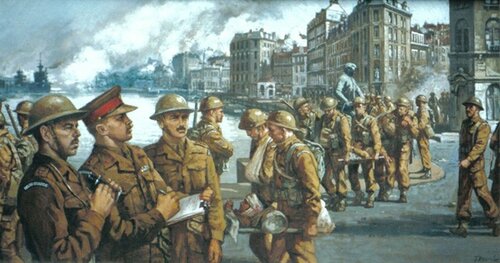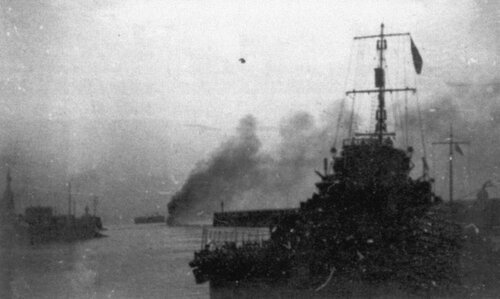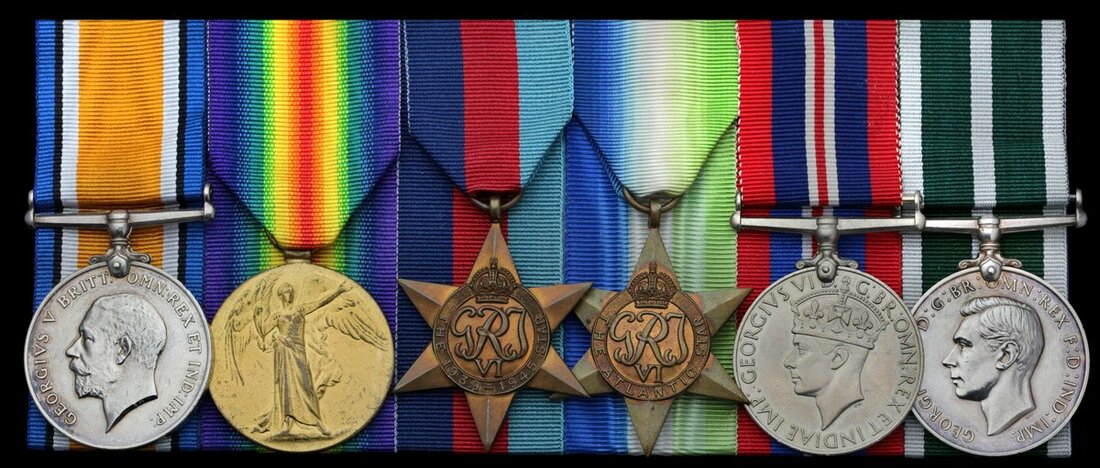Auction: 21003 - Orders, Decorations and Medals
Lot: 354
'I wish to express my admiration of the manner in which the Destroyers attached to the Dover Command carried out the difficult operation of evacuating the troops from Boulogne both in the face of heavy air attack and point-blank fire from guns, machine-guns and snipers. The handling of their ships and their armaments and the bearing of the ships' companies was beyond all praise. The following received from the CIGS [Chief of the Imperial General Staff] - Army's thanks to your people for last night's magnificent effort at Boulogne.'
A congratulatory message from the Vice-Admiral Destroyers, Dover, dated 24 May 1940, the recipients including the ship's company of H.M.S. Whitshed.
Six: Engine Room Artificer J. E. Johnson, Royal Navy, who served aboard H.M.S. Whitshed at Bolougne and Dunkirk in May 1940
British and Victory Medals (M.29486 J. E. Johnson. E.R.A. 5 R.N.); 1939-45 Star; Atlantic Star; War Medal 1939-45; Royal Naval Reserve L.S. & G.C., G.VI.R. (344 E.C., J.E. Johnson. E.R.A. R.N.R.), mounted for display, minor contact marking on first two, overall very fine (6)
John Edward Johnson was born at Newcastle, Northumberland on 2 January 1898 the son of Thomas and Susannah Johnson of Terrace Place, Newcastle. Johnson enlisted on 4 March 1918 as Engine Room Artificer Class V at Victory V being moving to the Destroyer Depot Ship H.M.S. Diligent from 14 May. Promoted Acting Engine Room Artificer Class IV on 2 June 1919 he was shore demobilised on 27 March 1919. Enlisting with the Royal Naval Reserve on 20 October 1924 he continued to serve throughout the interwar period. During this time he is noted as working as a Fitter with Armstrong Whitworth at Elswick shipyards from 23 March 1925. Johnson was still living in Newcastle with his wife Elsie Johnson in 1939 when he was called back to duty to the rank of Engine Room Artificer Class I.
Second World War
Serving first ashore at H.M.S. Victory II from 6 October 1939 he was then sent aboard H.M.S. Whitshed. He was still serving on this vessel when she sank U-55 in the South-West approaches on 30 January 1940. Transferred to Dover after the commencement of the German Blitzkrieg, she played a major role in the demolition of port facilities at IJmuiden and Amsterdam. On 14 May, as part of the operation to rescue the Dutch royal family, she evacuated a contingent of Irish and Welsh guards (Harpoon Force) from the Hook of Holland.
On 22 May, Whitshed was the escort leader for ships carrying troops of the 20th Guards Brigade to Boulogne. On her return journey, she carried RAF personnel, POWs and civilians back to England. With the situation in Boulogne rapidly deteriorating, Whitshed was back in Boulogne by 1500hrs on 23 May, to evacuate around 250 wounded soldiers. While there, she assisted the Irish Guards in taking out enemy positions in the town with her 4.7" guns. Later that evening, under air cover from the Royal Air Force, Whitshed, along with sister ship Vimiera, re-entered Boulogne and each ship embarked around a thousand men.
The following extract, taken from an article written by Major-General G. L. Verney, D.S.O., M.V.O. - for the Irish Guards Journal in 1957 - serves as a stirring tribute to the fine work carried out by Whitshed and eight other destroyers in the evacuation of Boulogne:
'There was no finer Naval enterprise during the late war than the evacuation from Boulogne by nine Destroyers, under close-range enemy fire, of the 2nd Battalions of the Irish and Welsh Guards and Headquarters, 20th Guards Brigade after a desperate 48 hours' defence of the port. With German artillery on the high ground less than a mile away, with enemy tanks on the quay on one side of the harbour, mortars, machine-guns and infantry in the houses and snipers on the roofs, the Destroyers came in two at a time - for the basin was too narrow for more - and took on board, first wounded and stragglers from the B.E.F. and Allied refugees, and then as many men of the two battalions as had been able to fight their way back through the town when the order for evacuation arrived.
Guardsmen, with seamen and marines of the demolition parties, fought as units together and held off the Germans for several hours while thousands of men were embarked and taken across the Channel, the task being made harder by numerous intense air attacks during which man bombs fell into the water so close to the ships that it seemed they could not survive. The accurate gunnery of the Navy excited the admiration of all; one enemy tank was sent spinning across the quay; snipers were blown off roofs; in one ship the mounting of a gun was blown away, but the gun was supported on the shoulders of some of its crew and continued firing.'
With defeat of the Allies in France Whitshed became part of the Royal Navy's effort to evacuate the B.E.F. from Dunkirk. Despite attacks by enemy aircraft and U-boats she came away unscathed through the operation. However she was struck by a mine off Harwich on 31 July 1940 which forced her to come into port for repair. Johnson left Whitshed on 5 August 1940. He served largely ashore for the rest of the conflict, seeing some service with H.M.S. Saltburn before being released to the Class A reserve on 18 September 1945; sold together with copied research including service records, census information and research into H.M.S. Whitshed.
The report of events at Boulogne can be read via:
http://www.holywellhousepublishing.co.uk/PDF/BoulogneRoP-WHITSHED.pdf
Subject to 20% VAT on Buyer’s Premium. For more information please view Terms and Conditions for Buyers.
Sold for
£350
Starting price
£110









